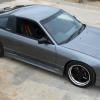Oil Control In Rb's For Circuit Drag Or Drift
Announcements
-
Similar Content
-
Latest Posts
-
I must have read 100 DIY's and watched 200 DIY Youtube videos with most people saying just grab a new cover and, well, despite my normal aproach to these things (replace it all!!) I didn't get a cover. I don't know why I didn't, I'd already ordered a bunch of bits from FCP and it would have made perfect sense to put that in the order. Anyway, I'm not getting OEM as its just crazy money, even from the states its 900 ish delivered. So, I got an OE Elring one, same as they sell at FCP but local so I can get this fixed this week. Our X5 is waiting for a new diff so we find ourselves in a common scenario of having 2 broken BMW's on the driveway! 🤣
-
By robbo_rb180 · Posted
Big thing is available inputs for sensors and not having to run multiple expander boxes and software packages for different things why motec is up there. The link ecu and an aim pdm32 was a combination I looked at early on so get ecu, dash and pdm in one go. Aim logging software is pretty good and has all the tracks I will ever drive. Having logging setup with tracks already available is a big thing for myself so can click drop down and go. Thing that I keep seeing is the support what's needed and having a package that people in the know are familiar with as learning a new platform is time consuming. Got a few boxes that arrived with bits while I was away so hopefully will fit a few sensors and make a start on the dump pipe today. Going to be interesting fitting a 3.5 inch exhaust on this and keeping it above the chassis rails. -
Chasing a R32 GTR dash pad, must be in good condition, no broken tabs, no holes and preferably no bubbles. Thanks
-
What's the highest HP figure from a 26/30 setup with standard crank?
-








Recommended Posts
Create an account or sign in to comment
You need to be a member in order to leave a comment
Create an account
Sign up for a new account in our community. It's easy!
Register a new accountSign in
Already have an account? Sign in here.
Sign In Now